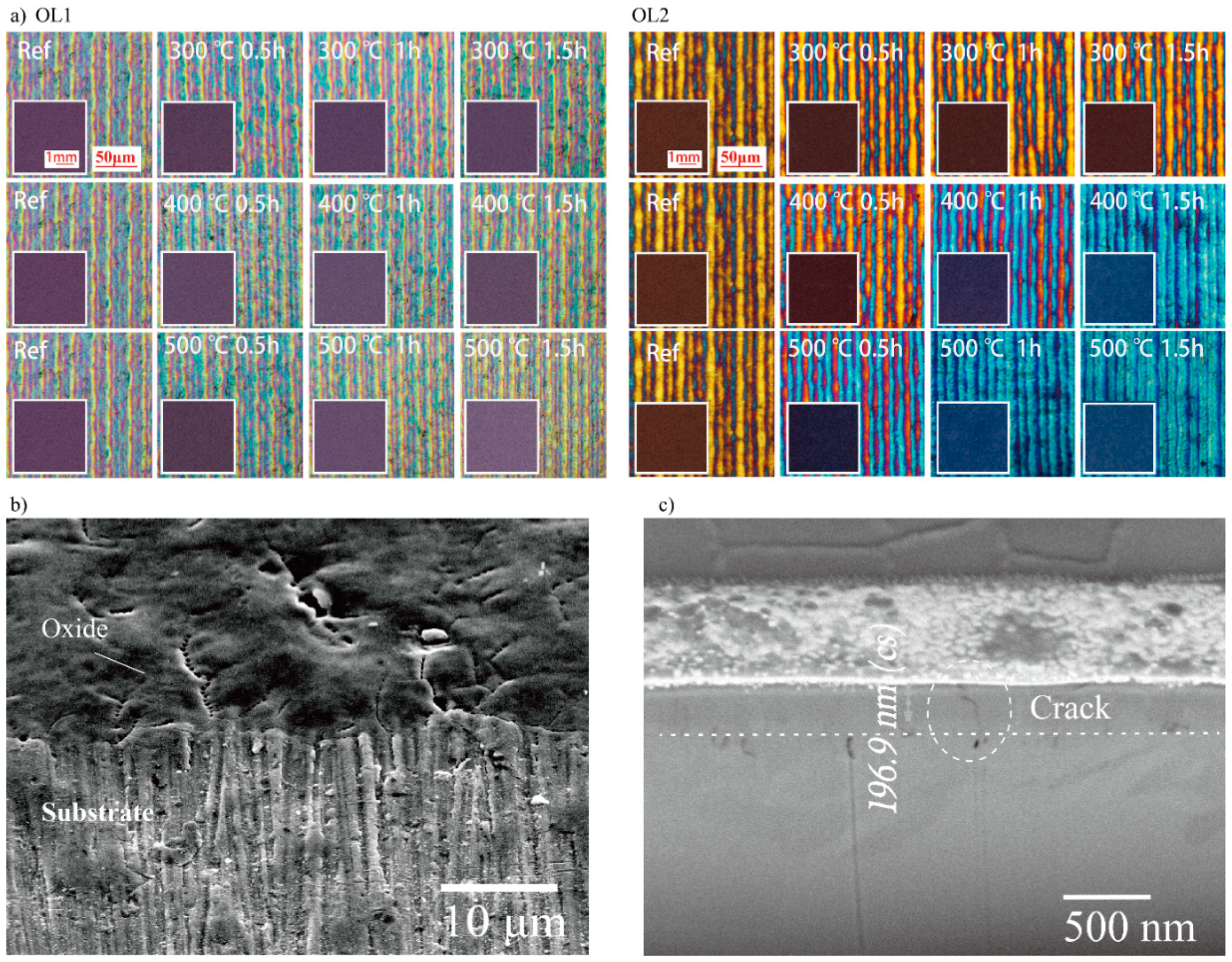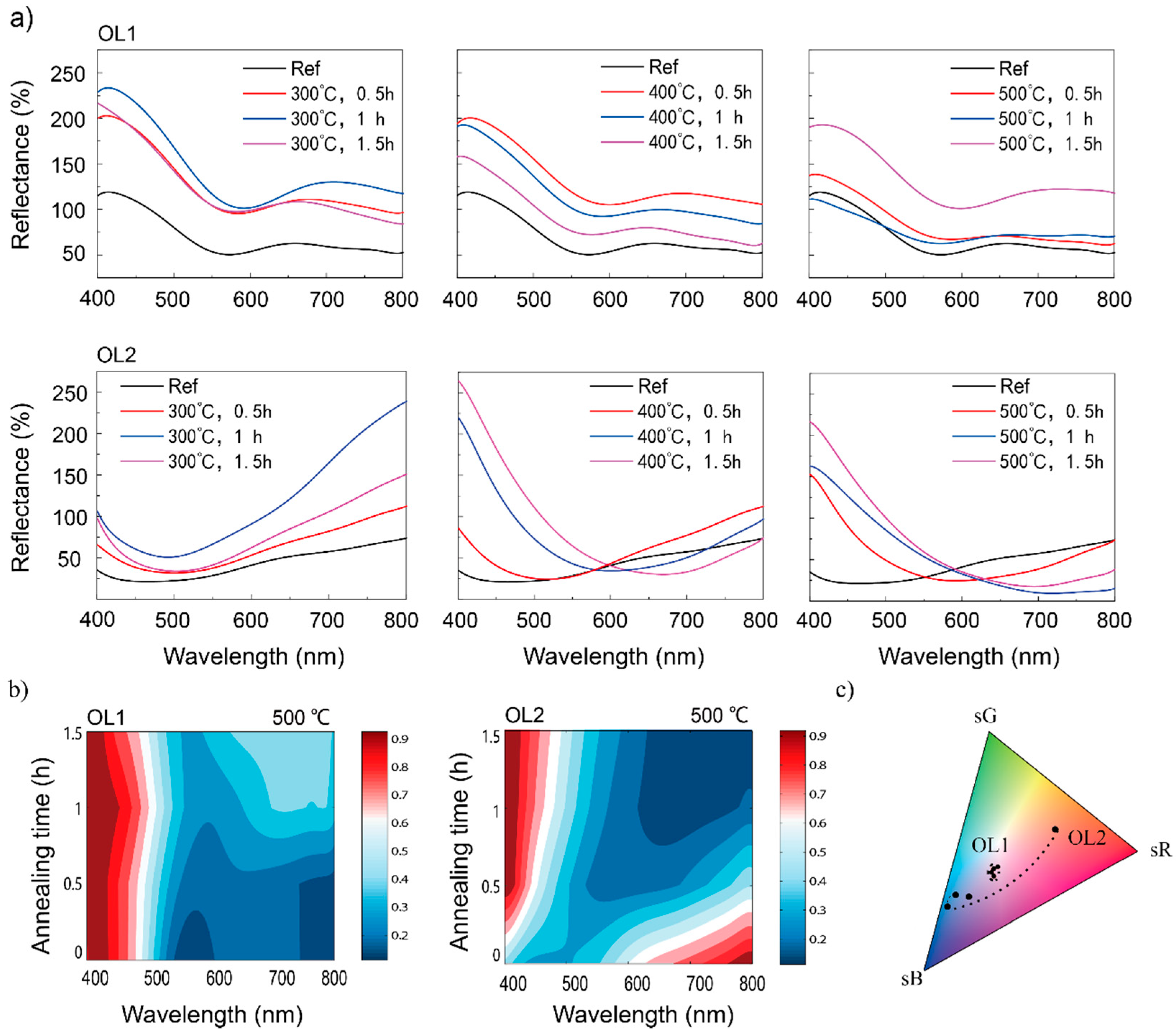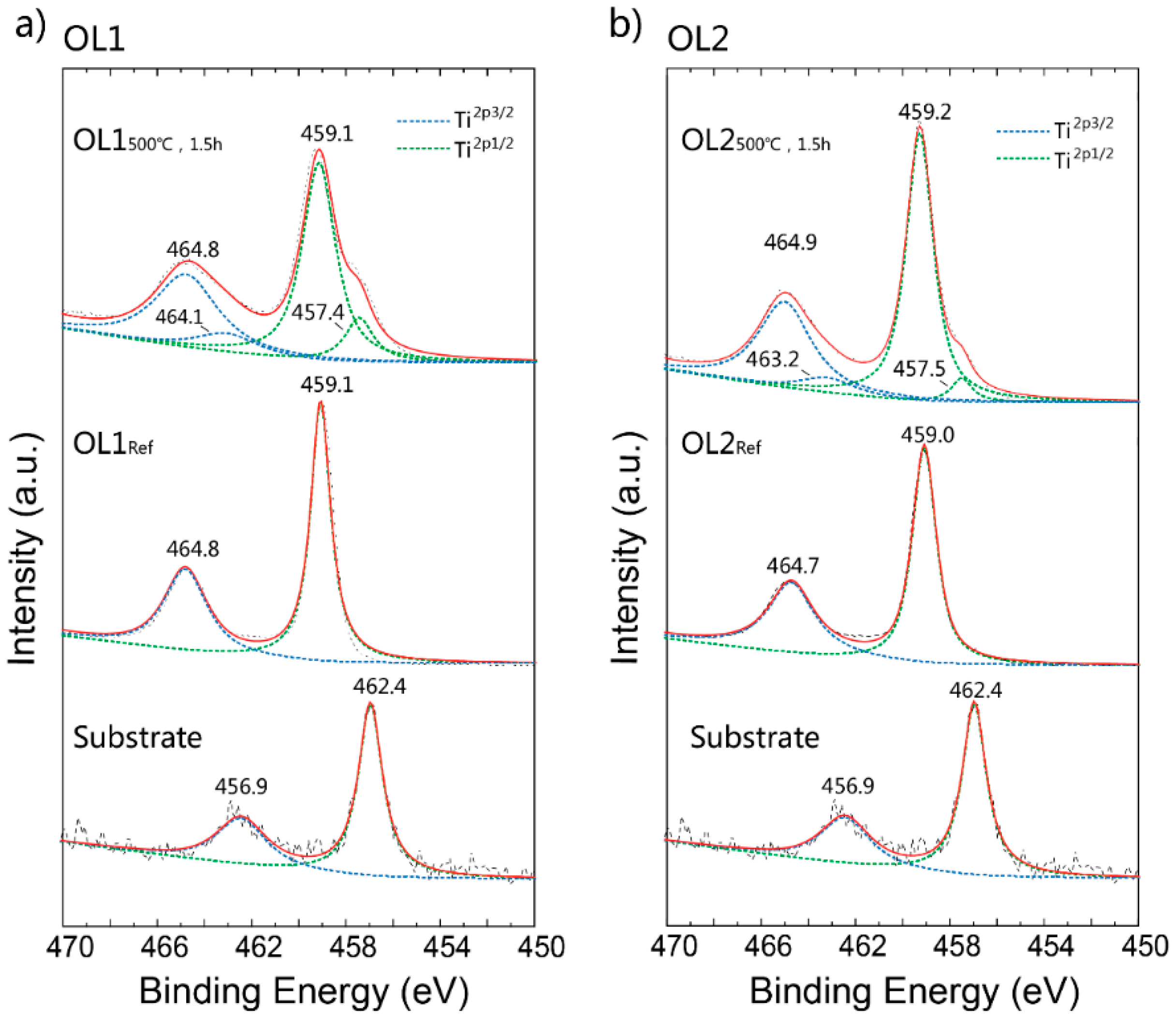Tunable Coloring via Post-Thermal Annealing of Laser-Processed Metal Surface
Abstract
:Featured Application
Abstract
1. Introduction
2. Materials and Methods
2.1. Laser Coloring and Thermal Treatment
2.2. Characterization
3. Results and Discussion
3.1. Optical Properties
3.2. Surface Chemical Compositions
3.3. Mechanism of Color Tuning
4. Conclusions
Author Contributions
Funding
Acknowledgments
Conflicts of Interest
References
- Sygletou, M.; Petridis, C.; Kymakis, E.; Stratakis, E. Advanced photonic processes for photovoltaic and energy storage systems. Adv. Mater. 2017, 29, 1700335. [Google Scholar] [CrossRef] [PubMed]
- Vorobyev, A.Y.; Guo, C. Direct femtosecond laser surface nano/microstructuring and its applications. Laser Photonics Rev. 2013, 7, 385–407. [Google Scholar] [CrossRef]
- Dusser, B.; Sagan, Z.; Foucou, A.; Jourlin, M.; Audouard, E. New applications in authentication and traceability using ultrafast laser marking. Int. Soc. Opt. Photonics 2009, 7201, 1–8. [Google Scholar]
- Zhu, X.; Yan, W.; Levy, U.; Mortensen, N.A.; Kristensen, A. Resonant laser printing of structural colors on high-index dielectric metasurfaces. Sci. Adv. 2017, 3, e1602487. [Google Scholar] [CrossRef] [PubMed] [Green Version]
- Chung, K.; Yu, S.; Heo, C.J.; Shim, J.W.; Yang, S.M.; Han, M.G.; Lee, H.S.; Jin, Y.; Lee, S.Y.; Park, N. Flexible, angle-independent, structural color reflectors inspired by morpho butterfly wings. Adv. Mater. 2012, 24, 2375–2379. [Google Scholar] [CrossRef] [PubMed]
- Jalali, M.; Yu, Y.; Xu, K.; Ng, R.J.; Dong, Z.; Wang, L.; Dinachali, S.S.; Hong, M.; Yang, J.K. Stacking of colors in exfoliable plasmonic superlattices. Nanoscale 2016, 8, 18228–18234. [Google Scholar] [CrossRef] [PubMed] [Green Version]
- Antończak, A.J.; Kocoń, D.; Nowak, M.; Kozioł, P.; Abramski, K.M. Laser-induced colour marking—Sensitivity scaling for a stainless steel. Appl. Surf. Sci. 2013, 264, 229–236. [Google Scholar] [CrossRef]
- Flauraud, V.; Reyes, M.; Paniagua-Dominguez, R.; Kuznetsov, A.I.; Brugger, J. Silicon nanostructures for bright field full color prints. ACS Photonics 2017, 4, 1913–1919. [Google Scholar] [CrossRef]
- Akman, E.; Cerkezoglu, E. Compositional and micro-scratch analyses of laser induced colored surface of titanium. Opt. Lasers Eng. 2016, 84, 37–43. [Google Scholar] [CrossRef]
- Veiko, V.; Odintsova, G.; Gorbunova, E.; Ageev, E.; Shimko, A.; Karlagina, Y.; Andreeva, Y. Development of complete color palette based on spectrophotometric measurements of steel oxidation results for enhancement of color laser marking technology. Mater. Des. 2016, 89, 684–688. [Google Scholar] [CrossRef]
- Adams, D.P.; Hodges, V.; Hirschfeld, D.; Rodriguez, M.A.; McDonald, J.; Kotula, P.G. Nanosecond pulsed laser irradiation of stainless steel 304L: Oxide growth and effects on underlying metal. Surf. Coat. Technol. 2013, 222, 1–8. [Google Scholar] [CrossRef]
- Luo, F.; Ong, W.; Guan, Y.; Li, F.; Sun, S.; Lim, G.; Hong, M. Study of micro/nanostructures formed by a nanosecond laser in gaseous environments for stainless steel surface coloring. Appl. Surf. Sci. 2015, 328, 405–409. [Google Scholar] [CrossRef]
- Yao, J.; Zhang, C.; Liu, H.; Dai, Q.; Wu, L.; Lan, S.; Gopal, A.V.; Trofimov, V.A.; Lysak, T.M. Selective appearance of several laser-induced periodic surface structure patterns on a metal surface using structural colors produced by femtosecond laser pulses. Appl. Surf. Sci. 2012, 258, 7625–7632. [Google Scholar] [CrossRef]
- Wu, T.; Wang, L.; Wei, C.; Zhou, M.; He, M.; Wu, L. Morphology and phase structures of CW laser-induced oxide layers on iron surface with evolving reflectivity and colors. Appl. Surf. Sci. 2016, 387, 1183–1187. [Google Scholar] [CrossRef]
- Del Pino, A.P.; Fernández-Pradas, J.; Serra, P.; Morenza, J. Coloring of titanium through laser oxidation: Comparative study with anodizing. Surf. Coat. Technol. 2004, 187, 106–112. [Google Scholar] [CrossRef]
- Khafaji, N.Y.; Demir, A.G.; Vitali, L.; Fustinoni, D.; Niro, A.; Previtali, B.; Taha, Z.A. Optical characterization of laser coloured titanium under different processing atmospheres. Surf. Coat. Technol. 2017, 321, 156–163. [Google Scholar] [CrossRef]
- Antończak, A.J.; Stępak, B.; Kozioł, P.E.; Abramski, K.M. The influence of process parameters on the laser-induced coloring of titanium. Appl. Phys. A 2014, 115, 1003–1013. [Google Scholar] [CrossRef]
- Li, Z.; Zheng, H.; Teh, K.; Liu, Y.; Lim, G.; Seng, H.; Yakovlev, N. Analysis of oxide formation induced by UV laser coloration of stainless steel. Appl. Surf. Sci. 2009, 256, 1582–1588. [Google Scholar] [CrossRef]
- Barmina, E.V.; Stratakis, E.; Fotakis, K.; Shafeev, G.A. Generation of nanostructures on metals by laser ablation in liquids: New results. Quantum Electron. 2010, 40, 1012. [Google Scholar] [CrossRef]
- Diamanti, M.V.; Del Curto, B.; Pedeferri, M. Interference colors of thin oxide layers on titanium. Color Res. Appl. 2008, 33, 221–228. [Google Scholar] [CrossRef]
- Göpel, W.; Anderson, J.A.; Frankel, D.; Jaehnig, M.; Phillips, K.; Schäfer, J.A.; Rocker, G. Surface defects of TiO2: A combined XPS, XAES AND ELS study. Surf. Sci. 1984, 139, 333–346. [Google Scholar] [CrossRef]
- Kurtz, R.L.; Henrich, V.E. Comparison of Ti 2p Core-Level Peaks from TiO2, Ti2O3, and Ti Metal by XPS. Surf. Sci. Spectra 1998, 5, 179–181. [Google Scholar] [CrossRef]
- Hauf, C.; Kniep, R.; Pfaff, G. Preparation of various titanium suboxide powders by reduction of TiO2 with silicon. J. Mater. Sci. 1999, 34, 1287–1292. [Google Scholar] [CrossRef]
- Sekiya, T.; Ichimura, K.; Igarashi, M.; Kurita, S. Absorption spectra of anatase TiO2 single crystals heat-treated under oxygen atmosphere. J. Phys. Chem. Solids 2000, 61, 1237–1242. [Google Scholar] [CrossRef]
- Huang, C.; Zhang, Y.; Shen, J.; Vilar, R. Thermal stability and oxidation resistance of laser clad TiVCrAlSi high entropy alloy coatings on Ti–6Al–4V alloy. Surf. Coat. Technol. 2011, 206, 1389–1395. [Google Scholar] [CrossRef]
- Zuo, F.; Wang, L.; Wu, T.; Zhang, Z.; Borchardt, D.; Feng, P. Self-doped Ti3+ enhanced photocatalyst for hydrogen production under visible light. J. Am. Chem. Soc. 2010, 132, 11856–11857. [Google Scholar] [CrossRef] [PubMed]
- Uno, M.; Nishimoto, S.; Kameshima, Y.; Miyake, M. Hydrogen production by mechano-chemical reaction of Ti2O3 in water. Int. J. Hydrogen Energy 2013, 38, 15049–15054. [Google Scholar] [CrossRef]
- Chen, L.W.; Zhou, Y.; Wu, M.X.; Hong, M.H. Remote-mode microsphere nano-imaging: New boundaries for optical microscopes. Opt. Electron. Adv. 2018, 1, 170001. [Google Scholar] [CrossRef]




| Element | OL1Ref | OL1500°C,1.5h | OL2Ref | OL2500°C,1.5h | |
|---|---|---|---|---|---|
| Atomic % | O | 24.0 | 70.0 | 14.6 | 66.1 |
| Ti | 70.9 | 25.6 | 79.3 | 29.4 | |
| C | 3.4 | 4.4 | 0.0 | 4.5 | |
| Cu | 1.7 | 0.0 | 6.1 | 0.0 |
| Area Ti3+/Ti4+ | Calculated O 1s/Ti 2p | Atomic O 1s/Ti 2p | |
|---|---|---|---|
| OL1Ref | / | 2 | 2.19 |
| OL1500°C,1.5h | 0.23 | 1.89 | 2.0 |
| OL2Ref | / | 2 | 2.4 |
| OL2500°C,1.5h | 0.12 | 1.94 | 2.21 |
© 2018 by the authors. Licensee MDPI, Basel, Switzerland. This article is an open access article distributed under the terms and conditions of the Creative Commons Attribution (CC BY) license (http://creativecommons.org/licenses/by/4.0/).
Share and Cite
Zhou, R.; Huang, T.; Lu, Y.; Hong, M. Tunable Coloring via Post-Thermal Annealing of Laser-Processed Metal Surface. Appl. Sci. 2018, 8, 1716. https://doi.org/10.3390/app8101716
Zhou R, Huang T, Lu Y, Hong M. Tunable Coloring via Post-Thermal Annealing of Laser-Processed Metal Surface. Applied Sciences. 2018; 8(10):1716. https://doi.org/10.3390/app8101716
Chicago/Turabian StyleZhou, Rui, Tingting Huang, Yuyao Lu, and Minghui Hong. 2018. "Tunable Coloring via Post-Thermal Annealing of Laser-Processed Metal Surface" Applied Sciences 8, no. 10: 1716. https://doi.org/10.3390/app8101716





